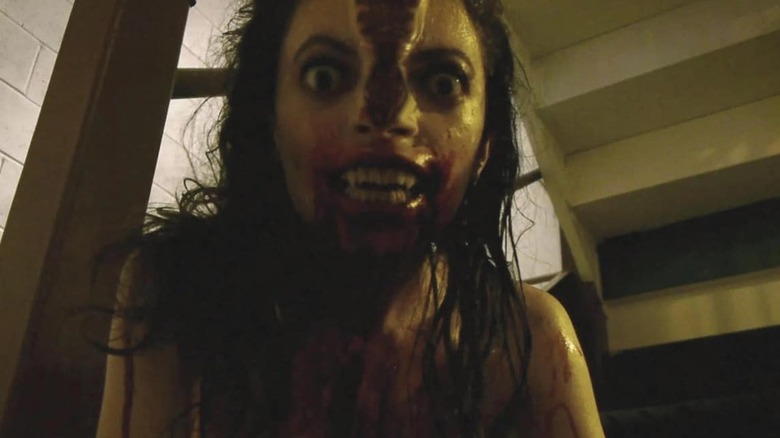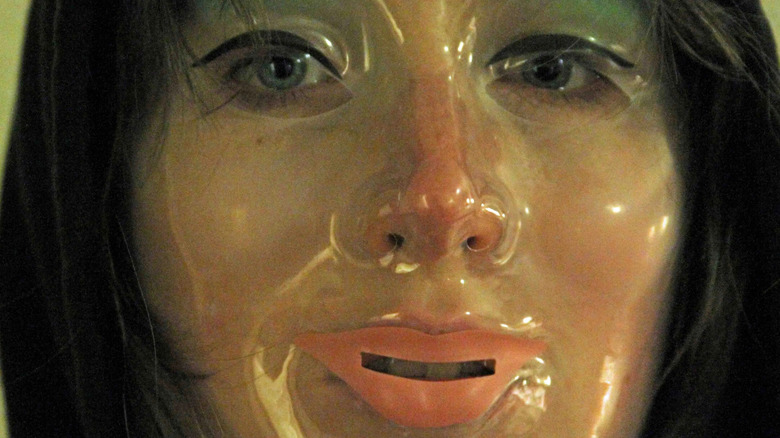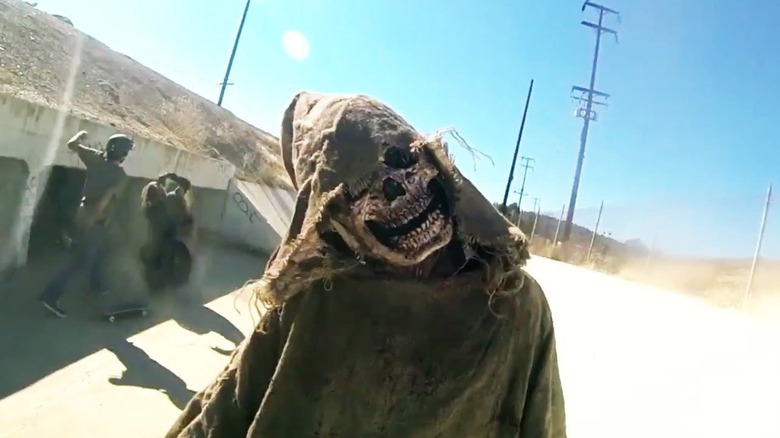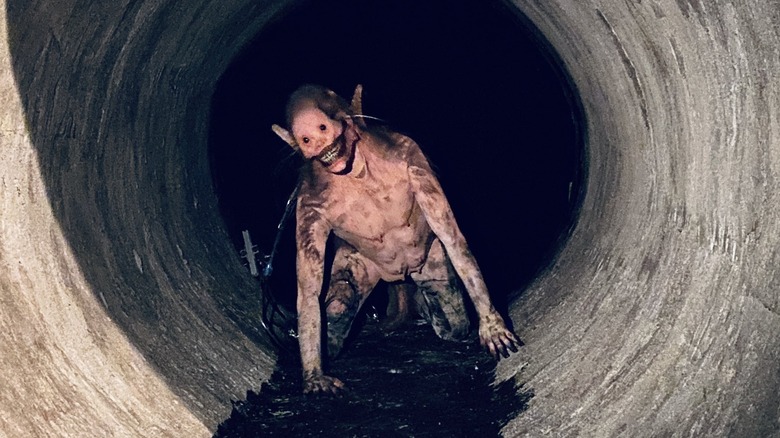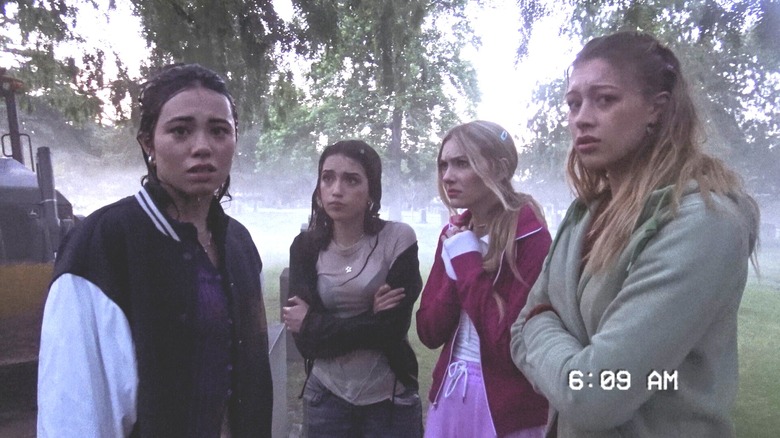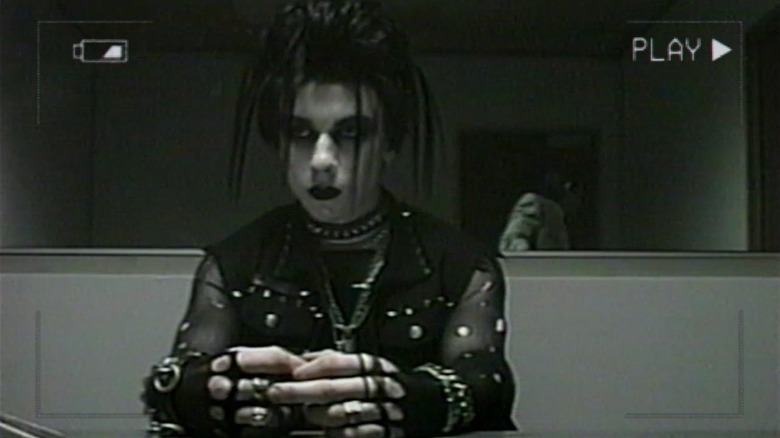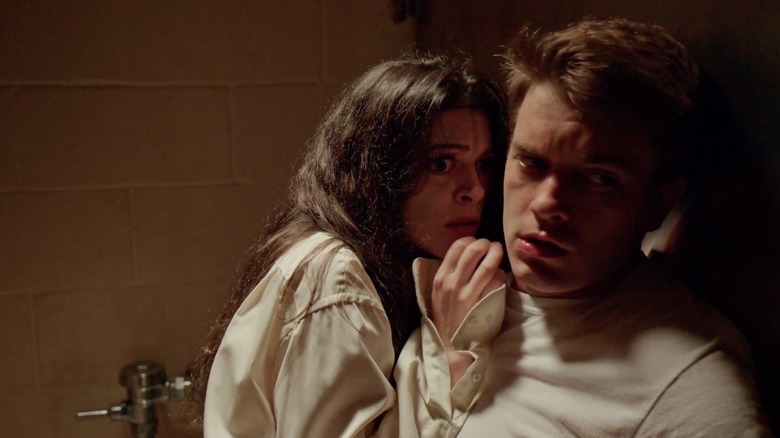How To Watch The V/H/S Movies In Order
Whether you're a longtime horror fan or a newcomer looking for something new to sample, the "V/H/S" films are a rewarding experience, because you get such a breadth of storytelling possibilities all contained in one franchise. Though each film in the series, and each short film contained within those films, is firmly within the found footage genre, it's there that the similarities often end. You can watch any one of these movies and get a wide variety of subgenres, storytelling techniques, and structural quirks, and because they're all self-contained, you can technically watch them in any order you want.
But even with that in mind, what's the best way to watch the "V/H/S" franchise, which has been churning out horror stories since 2012? Is there a clear order in which to best experience these movies? The answer is a resounding yes, and that order looks like this:
- "V/H/S"
- "V/H/S/2"
- "V/H/S: Viral"
- "V/H/S/94"
- "V/H/S/99"
- "V/H/S/85"
- "V/H/S/Beyond"
Why is that the correct order to watch the V/H/S movies?
As we've already mentioned, because these are anthology films that contain several smaller stories framed by one larger narrative, you really could just jump into any film in the "V/H/S" series and be just fine, keeping track of every individual story and the larger framework with ease. It's not a super continuity-heavy series.
That said, there are benefits to watching the films in the order we've described, which is also the order in which the films were released. By starting with "V/H/S," you get a clear introduction to the format of the series, several fun short horror films, and a frame story that gives a wonderful overall atmosphere. From that point you can easily slip into each subsequent movie, but that's certainly not the only reason to watch them this way.
In many cases, the "V/H/S" films are steered by the same creative teams, not just when it comes to producing the movies, but when it comes to writing and direction as well. Filmmakers, including Simon Barrett, Adam Wingard, David Bruckner, and Timo Tjahjanto, have all contributed to multiple films, and watching them in order gives you a chance to see how they're progressing as filmmakers and playing with the conventions of the franchise's format. There are also, of course, plenty of Easter eggs for careful viewers, and if you don't watch the films in release order, you might miss these.
With all that in mind, let's take a quick closer look at each individual film.
'V/H/S'
Released in 2012, the original "V/H/S" is framed around a seemingly abandoned house, where a corpse in a chair died while watching a series of mysterious tapes. When a group of young thieves breaks into the house with the mission of finding one specific tape, they begin to watch the ones they find as part of their search, falling victim to mysterious and dark forces along the way.
On the tapes themselves, they find everything from an encounter with a legendary creature, a dark tale of road trip murder, a Halloween party gone horribly wrong, an alien abduction story, and, perhaps most strikingly, a story in which a glitch on a camcorder actually becomes the monster in a slasher story.
This is, of course, the movie where it all begins, where the franchise establishes its format, the rules for depicting stories, and, of course, the wide variety of ways in which each creative team can interpret those rules. One story in the film unfolds through a camera hidden in a pair of eyeglasses, while another is told mostly via video chats on a computer screen. It's the very first film in the series, and already the filmmakers — who range from Radio Silence to Adam Wingard to Ti West – are having a blast playing with the core rules of what's set to become an essential found footage franchise.
'V/H/S/2'
Though you can watch any entry in this franchise by itself and come away having a good time, there is a lot of connective tissue between "V/H/S" and "V/H/S/2," specifically when it comes to the frame story. Once again helmed by Simon Barrett, the frame story for the sequel picks up where the last film left off, providing some context for what happened to the thieves in the last film and focusing on what happens next to the tapes they found, complete with a new mysterious house and, of course, a new stack of videos for a pair of private investigators to dig through.
What they discover is another set of strange, frightening tales that range from the story of a man who sees ghosts through a new ocular implant to a first-person view of a zombie outbreak to an investigation into a strange cult. There's even a story about kids trying to fend off an alien invasion during a slumber party.
Several key members of the original creative team returned to make new films within this entry, and the delivery systems for each individual story get even more experimental and fun this time around. Plus, if you've been paying attention, you can trace the connections between this frame story and the one in the original film, enriching the overall experience.
'V/H/S: Viral'
Building on the events in the frame stories of the previous two films, "V/H/S: Viral" presents a series of shorts that, in the universe of the franchise, went viral online after they were uploaded from the same VHS tapes in the original abandoned house from the first installment. That creates a sense of continuity between the films, as all three frame stories up to this point are connected by common characters and story threads. But when you get into the short films themselves, you're once again confronted with creative new riffs on the anthology's format.
The segments in this installment of the franchise include a seemingly never-ending chase involving an ice cream truck, a tale of frightening parallel universes, an occult encounter from the point of view of a group of skateboarders, and a magician who's overtaken by a frightening object in his collection. This time around, the segments get a little more experimental in tone and even occasionally break with the "found footage" consistency of the first two, making "Viral" arguably the most divisive film in the franchise. Still, it's an example of the series stretching its concept a bit, something that becomes very important for future films.
'V/H/S/94'
As the title suggests, "94" marks the first in a string of throwback "V/H/S" films that look at a specific point in the past, riffing not just on the video formats available at the time, but the pop culture and particular fears of the era. It also features a nice blend of established contributors to the "V/H/S" series and newcomers to the franchise.
For its segments, "94" offers riffs on various classic 1980s and 1990s subgenres. In the frame narrative, a SWAT team encounters occult activity and a series of mysterious television sets. In the segments, a woman must wait out a storm in a funeral home with only a seemingly unquiet corpse to keep her company, a cybernetic organism awakens after experimental surgery, and a white supremacist terror cell tries to use vampires as weapons. In the most famous segment of the film, "Storm Drain," a TV news reporter goes deep into a series of tunnels to seek out a strange creature known only as "Raatma."
The segments this time out are especially terrifying and fun, featuring contributions from "V/H/S" mainstays like Simon Barrett and Timo Tjahjanto alongside rising star filmmakers like Chloe Okuno and Jennifer Reeder. It's also the first film in the series disconnected from the overarching narrative established by the first three, providing audiences with a true standalone experience.
'V/H/S/99'
After the success of "V/H/S/94," the franchise's producers opted to continue with period pieces, and this time the film focuses on the turn of the millennium and all the horrors that came with the year 1999. Like "94," this is a film that focuses heavily on 1990s period details and formats. This installment also breaks from the previous films in several ways, including using a series of stop-motion films made with toy soldiers as interludes rather than delivering a single, larger frame story.
The segments this time around, directed largely by newcomers to the series, include the story of a riot grrl band breaking into a seemingly possessed old nightclub, a trip to Hell during a New Year's Eve party gone wrong, a sorority hazing ritual that turns into a terrifying tale of being buried alive, a demented game show recreated in a basement, and the story of a group of teen boys who get much more than they bargained for when they decide to spy on their attractive neighbor. Each segment riffs on a certain piece of 1990s pop culture, from Y2K fears to the rise of teen comedies like "American Pie," and directors include horror filmmakers like Maggie Levin, Flying Lotus, and Vanessa and Joseph Winter. Once again, it's a satisfyingly standalone piece of franchise filmmaking.
'V/H/S/85'
After two films set in the 1990s, the franchise dipped even further back in time to the golden age of VHS use, the 1980s, for a film steeped in '80s nostalgia, pop culture, and, of course, explorations of the era's public fascinations and favorite genres.
For the frame story, original "V/H/S" director David Bruckner returns with a faux TV documentary about a strange shapeshifting creature. In the individual segments, filmmakers like Scott Derrickson, Natasha Kermani, Gigi Saul Guerrero, and Mike P. Nelson cover everything from lakes with mysterious powers, serial killers engaged in a kind of familial killing ritual, the aftermath of the 1985 Mexico City earthquake, and a performance artist exploring the link between humanity and emerging computing technology.
Once again, it's a standalone movie experience, but it also contains a couple of intriguing firsts for a "V/H/S" film. Two of the segments — "No Wake" and "Ambrosia," both directed by Nelson — are part of the same story, with the latter serving as a direct sequel to the strange events of the former. Then there's "Dreamkill," the segment directed by Derrickson and co-written by Derrickson and C. Robert Cargill. Though the plot is entirely different, the characters in the segment are connected to the family depicted in Derrickson and Cargill's film "The Black Phone," making it a companion piece to a pre-existing horror movie. It's all fun connective tissue and one of the franchise's brightest installments.
'V/H/S/Beyond'
Moving away from the time period-specific installments, "V/H/S/Beyond" takes the franchise firmly into science fiction territory with several segments exploring alien encounters. The frame story, directed by "Cursed Films" mastermind Jay Cheel, is presented as a full-blown documentary featuring well-known UFO expert Mitch Horowitz and a couple of uniquely terrifying VHS tapes. From there, the film cycles through its segments, including another group of newcomers to the franchise.
The film's roster of directors, including Justin and Christian Long, Virat Pal, Justin Martinez, and Kate Siegel, dive deep into sci-fi horror with segments focusing on everything from a demented dog boarding business to a Bollywood star who's not quite human to a SWAT raid on a very strange compound to, in Siegel's directorial debut, the story of a woman who finds herself taken up in a spaceship while searching for UFOs. In what's arguably the most entertaining segment of the film, Martinez documents a skydiving journey gone horribly wrong when an alien invasion happens during the jump, and through it all, Cheel's moody, remarkably believable segment builds to a terrifying conclusion. It's quite possibly the most ambitious film in the franchise so far and makes excellent use of common themes in the segments.
Is there another way to watch the 'V/H/S' movies?
While watching the films in the order they were released offers the chance to see the evolution of its franchise and many of the filmmakers involved as "V/H/S" grows from anthology concept to full-blown horror sensation, there are a couple of other ways to experience the stories contained in these films.
The easiest way to mix things up is, as you might expect, built right into the concept of the franchise and its various installments. Because several of the films are set in specific years, you can re-arrange the series chronologically by setting, beginning with "85" and continuing on through the most recent installment, using the release dates of the non-year-themed films as a guide. If you choose that route, you'll get to see the VHS format as a medium progress with time, and the order looks like this:
- "V/H/S/85"
- "V/H/S/94"
- "V/H/S/99"
- "V/H/S"
- "V/H/S/2"
- "V/H/S: Viral"
- "V/H/S/Beyond"
Is there one more way to watch the V/H/S movies?
Though the first three films are linked by frame stories all set within the same expanding narrative, there's not a lot of continuity within the "V/H/S" films. It's just how they're designed, but that doesn't mean there's no room for more expansion in other ways.
Over the course of the franchise's history, two different segments – "Amateur Night" from "V/H/S" and "Slumber Party Alien Abduction" from "V/H/S/2" – have spun off into full-length feature films titled "Siren" and "Kids vs. Aliens," respectively. Because they're full-length films, and they're not fully found footage, they are very different experiences from watching the main series, but if you want to be a "V/H/S" movie completist, you can add them to the mix in the order in which they were released. That longer, more varied order of viewing looks like this:
- "V/H/S"
- "V/H/S/2"
- "V/H/S: Viral"
- "Siren"
- "V/H/S/94"
- "V/H/S/99"
- "Kids vs. Aliens"
- "V/H/S/85"
- "V/H/S/Beyond"

